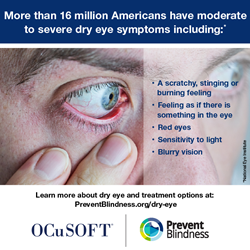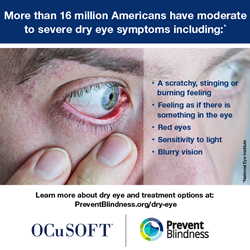
Prevent Blindness has declared July as Dry Eye Awareness Month.
“Fortunately, dry eye is highly treatable and there are many steps your eye doctor can recommend to get relief, including diet or lifestyle changes, using over-the-counter eyedrops or ointments, or taking prescription medications,” said Stephanie Marioneaux, MD, cornea & external disease specialist.
CHICAGO (PRWEB)
June 29, 2021
Nearly 16 million Americans have dry eye, according to the National Eye Institute (NEI). Dry eye occurs when there is not enough tear film produced, the tear film Is not draining properly from the eye, or the tear film is not the quality needed to maintain the health of the eye. Prevent Blindness, the nation’s oldest non-profit eye health organization, has declared July as Dry Eye Awareness Month in an effort to educate the public on risk factors, symptoms and treatment options.
Prevent Blindness has created a new web resource at https://preventblindness.org/understanding-dry-eye/ that offers free information on dry eye as well as downloadable fact sheets in English and Spanish. Shareable social media graphics are also available. Users are asked to use the hashtag #InYourEyes when posting on social media. OCuSOFT ® Inc., a privately-held eye and skin care company dedicated to innovation in eyelid hygiene and ocular health, is partnering with Prevent Blindness in support of July’s Dry Eye Awareness Month.
There are many symptoms of dry eye, such as burning or stinging sensation in the eye, a gritty or sandy feeling, redness and inflammation, and increased sensitivity to light. Additionally, those with dry eye experience extreme sensitivity, especially to cigarette smoke, including exposure to second-hand smoke. The NEI also states that if severe dry eye is not effectively treated, it can sometimes damage the cornea, the clear outer layer at the front of the eye.
Because dry eye is fairly common, there are many risk factors for dry eye, including:
- Being more than 50 years old
- Refractive surgery (for example, Lasik)
- Inflammation of the eyelids
- Environmental conditions, such as allergies, or a dry climate
- Wearing contact lenses
- Certain medications (including those used to treat eye conditions such as glaucoma)
- Medical conditions such as rheumatoid arthritis, Sjogren’s syndrome, and certain other autoimmune diseases
Additionally, women are twice as likely to develop dry eye than men. Women who are pregnant, on certain types of birth control, hormone replacement therapy, or experiencing menopause are also more likely to have dry eye.
The American Academy of Ophthalmology also states that diabetes and thyroid dysfunction can cause dry eye. Increased screen time on devices also contributes to dry eye symptoms.
“Fortunately, dry eye is highly treatable and there are many steps your eye doctor can recommend to get relief, including diet or lifestyle changes, using over-the-counter eyedrops or ointments, or taking prescription medications,” said Stephanie Marioneaux, MD, cornea and external disease specialist, and member of the Prevent Blindness volunteer board of directors. “The best way to protect your vision is to get a comprehensive eye exam to make sure your eyes are healthy today and you can take care of your sight in the future.”
For more information on dry eye, please call Prevent Blindness at (800) 331-2020, or visit https://preventblindness.org/understanding-dry-eye/.
About Prevent Blindness
Founded in 1908, Prevent Blindness is the nation’s leading volunteer eye health and safety organization dedicated to fighting blindness and saving sight. Focused on promoting a continuum of vision care, Prevent Blindness touches the lives of millions of people each year through public and professional education, advocacy, certified vision screening and training, community and patient service programs and research. These services are made possible through the generous support of the American public. Together with a network of affiliates, Prevent Blindness is committed to eliminating preventable blindness in America. For more information, visit us at preventblindness.org, and follow us on Facebook, Twitter, Instagram and LinkedIn.
Share article on social media or email:

